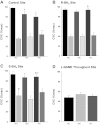Tetrahydrobiopterin increases NO-dependent vasodilation in hypercholesterolemic human skin through eNOS-coupling mechanisms
- PMID: 23193114
- PMCID: PMC3543657
- DOI: 10.1152/ajpregu.00448.2012
Tetrahydrobiopterin increases NO-dependent vasodilation in hypercholesterolemic human skin through eNOS-coupling mechanisms
Abstract
Localized exogenous R-tetrahydrobiopterin (R-BH(4)) corrects the deficit in local heat-induced vasodilation (VD) in hypercholesterolemic (HC) human skin through one of two plausible mechanisms: by serving as an essential cofactor to stabilizing endothelial nitric oxide (NO) synthase (eNOS) or through generalized antioxidant effects. We used the stereoisomer S-BH(4), which has the same antioxidant properties but does not function as an essential NOS cofactor, to elucidate the mechanism by which R-BH(4) restores cutaneous VD in HC humans. Intradermal microdialysis fibers were placed in 20 normocholesterolemic (NC), 13 midrange cholesterolemic (MC), and 18 HC (LDL: 94 ± 3, 124 ± 3 and 179 ± 6 mg/dl, respectively) men and women to perfuse Ringer (control site) and R-BH(4). In 10 NC, 13 MC, and 9 HC subjects (LDL: 94 ± 3, 124 ± 3, 180 ± 10 mg/dl), S-BH(4) was perfused at a third microdialysis site. Skin blood flow was measured during a standardized local heating protocol to elicit eNOS-dependent VD. After cutaneous vascular conductance (CVC = LDF/MAP) plateaued, NO-dependent VD was quantified by perfusing N(G)-nitro-l-arginine methyl ester (l-NAME). Data were normalized as %CVC(max). Fully expressed VD (NC: 97.9 ± 2.3 vs. MC: 85.4 ± 5.4, HC: 79.9 ± 4.2%CVC(max)) and the NO-dependent portion (NC: 62.1 ± 3 vs. MC: 45.8 ± 3.9, HC: 35.7 ± 2.8%CVC(max)) were reduced in HC (both P < 0.01 vs. NC), but only the fully expressed VD was reduced in MC (P < 0.01 vs. NC). R-BH(4) increased the fully expressed (93.9 ± 3.4%CVC(max); P < 0.01) and NO-dependent VD (52.1 ± 5.1%CVC(max); P < 0.01) in HC but not in NC or MC. S-BH(4) increased full-expressed VD in HC (P < 0.01) but did not affect NO-dependent VD in HC or MC. In contrast S-BH(4) attenuated NO-dependent VD in NC (control: 62.1 ± 3 vs. S-BH(4): 41.6 ± 7%CVC(max); P < 0.001). Exogenous R-BH(4) restores NO-dependent VD in HC human skin predominantly through NOS coupling mechanisms but increases full expression of the local heating response through generalized antioxidant properties.
Figures



Similar articles
-
Edward F. Adolph Distinguished Lecture: Skin-deep insights into vascular aging.J Appl Physiol (1985). 2017 Nov 1;123(5):1024-1038. doi: 10.1152/japplphysiol.00589.2017. Epub 2017 Jul 20. J Appl Physiol (1985). 2017. PMID: 28729391 Free PMC article. Review.
-
Acute localized administration of tetrahydrobiopterin and chronic systemic atorvastatin treatment restore cutaneous microvascular function in hypercholesterolaemic humans.J Physiol. 2011 Oct 1;589(Pt 19):4787-97. doi: 10.1113/jphysiol.2011.212100. Epub 2011 Aug 1. J Physiol. 2011. PMID: 21807618 Free PMC article. Clinical Trial.
-
Local tetrahydrobiopterin administration augments reflex cutaneous vasodilation through nitric oxide-dependent mechanisms in aged human skin.J Appl Physiol (1985). 2012 Mar;112(5):791-7. doi: 10.1152/japplphysiol.01257.2011. Epub 2011 Dec 8. J Appl Physiol (1985). 2012. PMID: 22162527 Free PMC article.
-
Oral atorvastatin therapy increases nitric oxide-dependent cutaneous vasodilation in humans by decreasing ascorbate-sensitive oxidants.Am J Physiol Regul Integr Comp Physiol. 2011 Sep;301(3):R763-8. doi: 10.1152/ajpregu.00220.2011. Epub 2011 Jun 29. Am J Physiol Regul Integr Comp Physiol. 2011. PMID: 21715698 Free PMC article. Clinical Trial.
-
Gender bias in gastroparesis: is nitric oxide the answer?Dig Dis Sci. 2011 Sep;56(9):2520-7. doi: 10.1007/s10620-011-1735-6. Epub 2011 May 11. Dig Dis Sci. 2011. PMID: 21559738 Free PMC article. Review.
Cited by
-
Regulation of exercise blood flow: Role of free radicals.Free Radic Biol Med. 2016 Sep;98:90-102. doi: 10.1016/j.freeradbiomed.2016.01.017. Epub 2016 Feb 10. Free Radic Biol Med. 2016. PMID: 26876648 Free PMC article. Review.
-
The colours of humanity: the evolution of pigmentation in the human lineage.Philos Trans R Soc Lond B Biol Sci. 2017 Jul 5;372(1724):20160349. doi: 10.1098/rstb.2016.0349. Philos Trans R Soc Lond B Biol Sci. 2017. PMID: 28533464 Free PMC article. Review.
-
Impaired microvascular reactivity in patients treated with 5-fluorouracil chemotherapy regimens: Potential role of endothelial dysfunction.Int J Cardiol Heart Vasc. 2023 Nov 17;49:101300. doi: 10.1016/j.ijcha.2023.101300. eCollection 2023 Dec. Int J Cardiol Heart Vasc. 2023. PMID: 38173789 Free PMC article.
-
Edward F. Adolph Distinguished Lecture: Skin-deep insights into vascular aging.J Appl Physiol (1985). 2017 Nov 1;123(5):1024-1038. doi: 10.1152/japplphysiol.00589.2017. Epub 2017 Jul 20. J Appl Physiol (1985). 2017. PMID: 28729391 Free PMC article. Review.
-
Endothelial dysfunction and cardiovascular disease.Glob Cardiol Sci Pract. 2014 Oct 16;2014(3):291-308. doi: 10.5339/gcsp.2014.43. eCollection 2014. Glob Cardiol Sci Pract. 2014. PMID: 25780786 Free PMC article. Review. No abstract available.
References
-
- Cosentino F, Hurlimann D, Delli Gatti C, Chenevard R, Blau N, Alp NJ, Channon KM, Eto M, Lerch P, Enseleit F, Ruschitzka F, Volpe M, Luscher TF, Noll G. Chronic treatment with tetrahydrobiopterin reverses endothelial dysfunction and oxidative stress in hypercholesterolemia. Heart 94: 487–492, 2008 - PubMed
-
- Cunnington C, Van Assche T, Shirodaria C, Kylintireas I, Lindsay AC, Lee JM, Antoniades C, Margaritis M, Lee R, Cerrato R, Crabtree MJ, Francis JM, Sayeed R, Ratnatunga C, Pillai R, Choudhury RP, Neubauer S, Channon KM. Systemic and vascular oxidation limits the efficacy of oral tetrahydrobiopterin treatment in patients with coronary artery disease. Circulation 125: 1356–1366, 2012 - PMC - PubMed
-
- Debbabi H, Bonnin P, Ducluzeau PH, Leftheriotis G, Levy BI. Noninvasive assessment of endothelial function in the skin microcirculation. Am J Hypertens 23: 541–546, 2010 - PubMed
Publication types
MeSH terms
Substances
Grants and funding
LinkOut - more resources
Full Text Sources
Other Literature Sources
Medical

